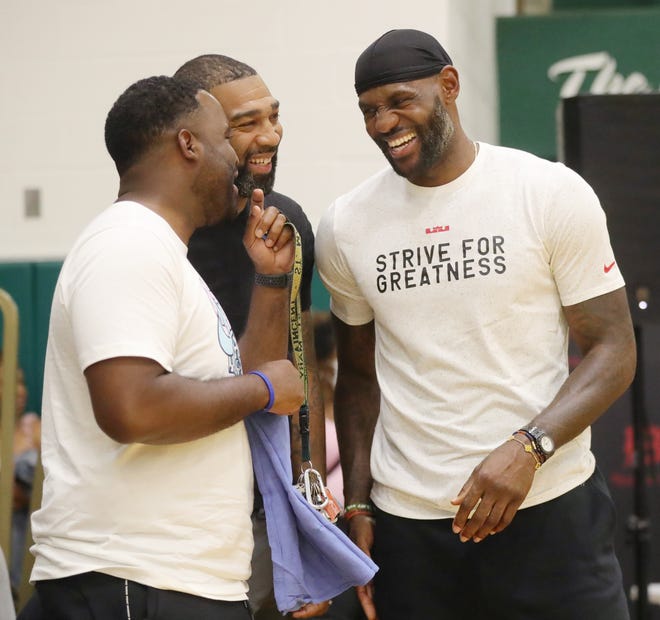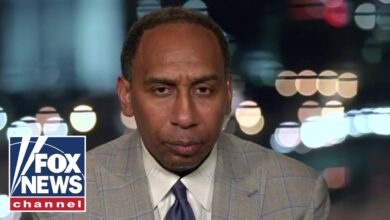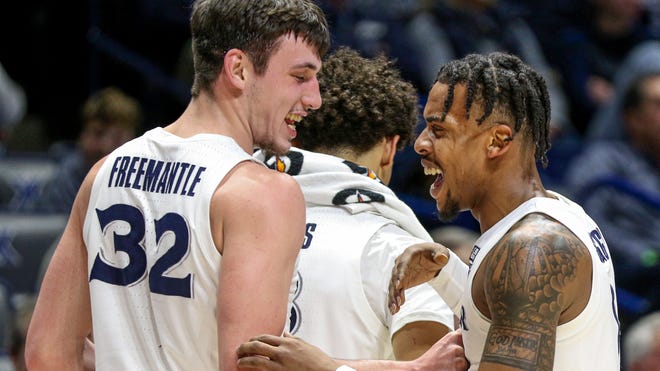
![Former teammates Willie McGee, Romeo Travis, and LeBron James share a few laughs while watching Bronny James and his Strive for Greatness teammates take on the Midwest Basketball Club in a AAU game at LeBron James Arena on Friday, July 2, 2021 in Akron, Ohio. [Phil Masturzo/ Beacon Journal]](https://cdn.cincylink.com/pub/content/uploads/sites/27/2021/07/How-private-schools-in-Ohio-draw-star-high-school-athletes.jpg)
EDITOR'S NOTE: This is the second in a five-part series examining the competitive balance issue in Ohio high school athletics. Miss the first part, click here to read about the long quest to address the issue.
Willie McGee’s tale of how he ended up at St. Vincent-St. Mary in the early 2000s is well known. After all, it’s directly linked to the journey of one of the greatest basketball players of all time.
McGee, along with childhood friends LeBron James, Sian Cotton and Dru Joyce III, enrolled at the private school in the fall of 1999. Once Romeo Travis joined them with the Irish, Akron’s “Fab Five,” as they’ve been known, would go on to win state basketball championships, while not being too bad on the football field either.
More than a decade-and-a-half later, McGee’s path has returned him to St. Vincent-St. Mary, this time as its athletics director. Reflecting back, even without the benefit of hindsight, he feels the path they chose was the right one, for a variety of reasons.
“I have to be honest, we chose to come to St. V because we all wanted to stay together,” McGee said. “You couldn’t tell any of the four of us, and the five of us when Romeo joined us, that if we would’ve went to an Akron Public School, we wouldn’t have had that same success in winning state championships. … We feel our chemistry being together and coming together was a large part of the success that we had.”

For five kids from the city of Akron, it was a choice they made to follow a coach, Dru Joyce II, they had grown up with. The elder Joyce had coached them as youth, and then joined Keith Dambrot’s Irish staff in 1999 before taking over for Dambrot in 2001
Since 2000, St. Vincent-St. Mary has won seven state championships and finished second three other times. That success, and the lure of playing at the same place LeBron James did, has been a magnet for players to show up to play for the Irish.
![STVM boys basketball coach Dru Joyce reacts on the sideline during the second half of the Division II state championship game against St. Francis DeSales, Sunday, March 21, 2021, in Dayton, Ohio. [Jeff Lange/Beacon Journal]](https://cdn.cincylink.com/pub/content/uploads/sites/27/2021/07/How-private-schools-in-Ohio-draw-star-high-school-athletes.JPG)
Joyce, though, feels there’s a two-way street that exists for the players who show up to play for him. That’s based on the standards that have been created that go well beyond winning.
“I just believe in what we do,” Joyce said. “We have a process here. We lose a lot of kids because kids have to wait their turn because there’s so many good players that want to be here. That’s not the mentality of today’s kid. The mentality of today’s kid is, ‘I’ve got to play and I’ve got to play right now.’ So we probably lose more kids than we gain.”
That’s a statement that, if one talks to a lot of individuals working in private schools, they hear in general. That’s not just taking into account athletes, but students as a whole.
That’s why the private schools are willing to cast out a wide net to bring in students. Various Catholic diocese have implemented boundaries in the past, with high schools restricted to just a certain area of an urban area, but that rarely exists anymore.
The one exception is in Columbus, where the four Diocese of Columbus-affiliated high schools within the city limits – Bishop Hartley, Bishop Ready, Bishop Watterson and St. Francis DeSales – essentially divide the city up into quadrants. The lone exception is St. Charles High School, which is independent of the diocese, and also the lone single-gender school among the five (boys only).
“I think we're probably unique,” Bishop Hartley football coach Brad Burchfield said. “I know that they set up these boundaries many years ago to try to make sure that we had a sense of community within our schools and within our areas. The setup also kind of prepares identification with the high school. … I’m sure you’d have some parishes that identify with, like, a St. Xavier. I just don’t know.”

Outside of Columbus, though, communities can be a feeder area for any number of schools. That’s both private and public schools.
One school district which has seen a percentage of the school-aged children within its district boundaries go off to various private schools is the Stow-Munroe Falls City School District. Its location puts families in position where there are no fewer than five private high schools — Walsh Jesuit and Cuyahoga Valley Christian Academy in neighboring Cuyahoga Falls, and Archbishop Hoban, St. Vincent-St. Mary and the girls-only Our Lady of the Elms in Akron — within a roughly 20-minute drive.
Many of those families are members of the Holy Family parish in Stow. It’s from that feeder school that not only the private high schools, but also the public high school, draws a sizable percentage of students.
“We need to get into Holy Family and recruit our own,” Stow-Munroe Falls Athletics Director Cyle Feldman said. “By that I mean, if you look at Holy Family’s eighth-grade class, a third go to Walsh, a third go to St. V or Hoban combined, maybe a little more to Hoban, and then a third come to Stow. … Historically, when you look back and monitor that group in the four years of high school, they’re pretty good. I’m talking athletically and academically.”

What happens with Stow and its neighboring private schools is something that is the norm for many of the suburban public schools around Cleveland, Akron and Cincinnati. For every student who may come up through a private feeder school within a certain public school district that chooses to go to the public high school once they reach the ninth grade, there’s just as great a likelihood that the student will choose to continue on in the private-school realm.
One thing that most of the mid- to large-sized private schools, in particular, have is a natural pipeline of students who come from families who have attended a given school over multiple generations. In Cincinnati, there are “Elder families” and “Moeller families” and “La Salle families,” while St. Ignatius, for example, prides itself on the number of prominent alumni it has around Greater Cleveland.
That creates a dynamic among the private school where a large percentage of its students are multi-generational legacies. Anecdotally, it could even be argued that that number would be higher than what you would see at a public school such as Jackson, an upper-middle class district located in an area of rapidly-growing population in western Stark County.
“I don’t know if I know the exact number, but I can tell that the number of legacy students that go through here is very, very high,” St. Ignatius Athletics Director Rory Fitzpatrick said. “That’s a great thing for the institution. Listen, we opened our doors in 1886. I don’t know when a school like Jackson opened, but I know it wasn’t 1886. So we do have that benefit.”

There’s another benefit that some opposed to private schools believe those schools, or many of those schools, possess. That would be the Ohio EdChoice Scholarship Program, which provides $4,650 for kindergarten through eighth-grade students, and $6,000 for those in high school to go toward the cost of tuition at a private school.
To be eligible for that program, the student has to come from a family with an income of no more than 200% of the federal poverty level. They also have to attend one of the designated 473 school buildings across 87 public school districts, which includes both urban and rural districts.
More:Northwest to join court challenge of EdChoice school voucher program
More:Ohio Senate increases both cuts taxes and school vouchers in their state budget
Private-school administrators and coaches point out that very few schools are bringing in a student solely on EdChoice money. That money would only cover between half to two-thirds of the tuition costs for many private schools.
“Even if you get an EdChoice kid, what people are forgetting is if we’re getting an EdChoice kid for $6,500, we still have to bankroll that other $6,500,” said T.K. Griffith, interim principal and boys basketball coach at Hoban. “It’s about $13,000 to go to Hoban. We still have to grant-in-aid that other $6,500, and that’s coming from our financial aid resources. It’s not like we’re making $12,000 off this youngster. There’s still a deficit for us to pay our teachers and everything.”
Still, since that program was started in 2006, it has created a certain level of conflict in educational circles between public schools trying to keep students and private schools trying to get students in order to stay open. Athletics are, if one were to compare a school (or school district) to a house, the front porch, the thing that is most visible to the person just passing by.

Administrators and coaches on both sides agree that the athletics debate may just be part of the overall public-private debate in education.
“I think it’s easier to pick the athletic piece of that because most people can have that conversation and say, ‘This is a public-private athletic conversation,’” Triway Schools Superintendent Nate Schindewolf said. “It’s way bigger than that. I feel like there’s the EdChoice and all the different layers to that. It’s always going to be easier to say this is about athletics because it’s a familiar topic. It’s very polarizing."
Next: Public schools may have boundaries to which they have to adhere, but open enrollment has created much more elasticity for them to draw in students (and athletes).
Reach Chris at [email protected].
On Twitter: @ceasterlingINDE
Source link




